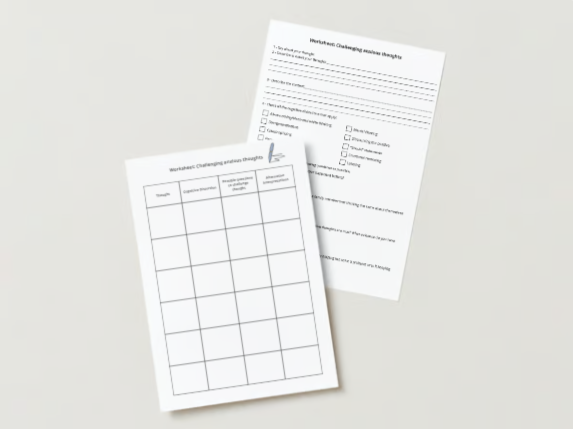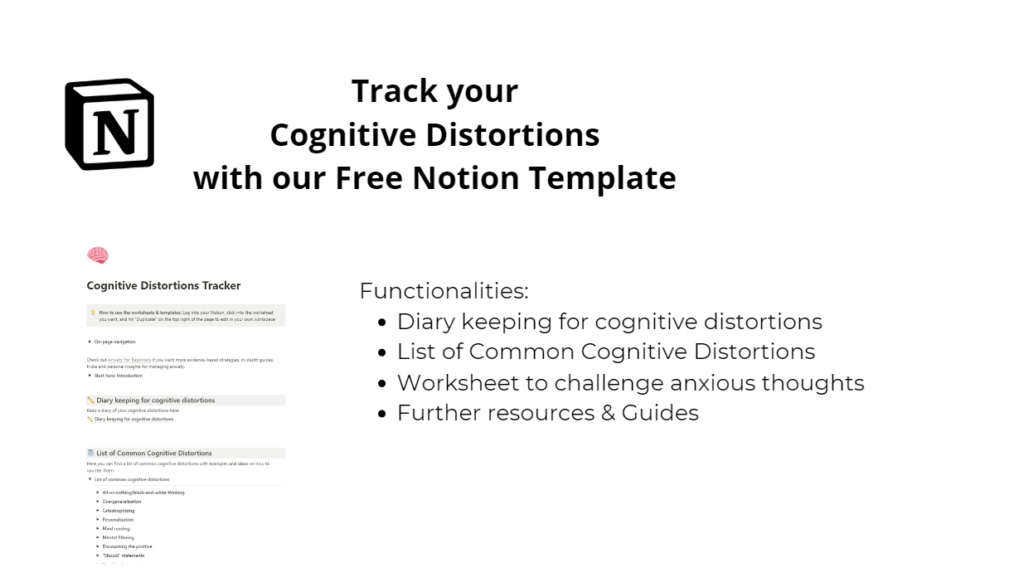This Challenging Anxious Thoughts Worksheet provides strategies and exercises to challenge and reframe negative thoughts, helping you to gain a greater sense of control over your anxiety.
In this worksheet, we are going to help you challenge your anxious thoughts with the help of CBT therapy skills, by identifying your irrational negative thoughts (also called cognitive distortions), and challenging them.
Get the free WorksheetCognitive distortions
Cognitive distortions are irrational and negative thoughts. The first step to deal with them is awareness.
You can also check out our more in-depth guide about Cognitive Distortions.
We will discuss some common cognitive discussions, and provide some examples. Here you have a list of these “thinking traps” or automatic negative thoughts:
- All-or-nothing/black-and-white thinking
The all-or-nothing thinking is about perceiving situations in extreme and polarized terms, (you see things as either all good or all bad), with no middle ground or shades of gray.
Example: “If I’m not perfect, they’ll leave me,” assuming that any flaws will automatically lead to rejection, without considering that healthy relationships involve understanding and accepting imperfections.
- Overgeneralization
Taking a specific instance or experience and applying it to all situations, events, or people. Making a conclusion based on a single occurrence.
Example: After being rejected once for a date, thinking “No one is ever going to want to be with me.” However, a single rejection does not mean you are universally undesirable. There are possibilities of future positive relationships and we should not disregard the complexity of individual preferences and circumstances.
- Catastrophizing
Imaging the worst possible outcome of situation and blowing it out of proportion.
Example: After making a minor mistake in a presentation at work, Lisa starts catastrophizing, imagining that she’s going to lose her job, that her career is ruined, and that she’ll end up unemployed and destitute. In reality, the mistake was relatively insignificant and unlikely to lead to such extreme consequences.
- Personalization
Tendency to take external events or other people’s behaviors personally, even when they have little to do with the individual. Attributing the actions or reactions of others to themselves, assuming that they are the cause, even when other factors are likely at play.
Example: When a friend cancels plans to hang out, Sarah immediately thinks, “They must not want to spend time with me because I’m boring.” In reality, her friend might have canceled due to their own busy schedule or other commitments.
- Mind reading
Assumption that one knows the thoughts, feelings, or intentions of others without any concrete evidence.
Example: During a group discussion, Mark assumes that Sarah is upset with him because she’s not making eye contact. He concludes that she must think he’s boring and annoying. In reality, Sarah might be preoccupied with something unrelated and her lack of eye contact has nothing to do with Mark.
- Mental filtering
Focusing selectively on negative or distressing aspects of a situation while ignoring or discounting the positive or neutral aspects.
Example: After receiving a performance review with numerous positive comments and one piece of constructive criticism, Emily fixates solely on the criticism. She discounts all the praise she received and becomes convinced that she’s a failure in her job.
- Discounting the positive
Minimizing or dismissing positive experiences, qualities or achievements, often downplaying their significance or attributing them to external factors.
Example: Despite receiving praise for his artwork, Alex consistently discounts the positive by saying, “It’s not a big deal; anyone could do that.” He fails to recognize his artistic talent and undermines his achievements, disregarding the effort and skill he put into his work.
(Mental filtering and discounting the positive are very similar)
- “Should” statements
Imposing rigid and unrealistic expectations on oneself or others.
Example: Samantha constantly tells herself, “I should always be perfect in everything I do.” This places an unrealistic and unattainable standard on herself. When she inevitably falls short of perfection, she feels like a failure and experiences a great deal of stress and anxiety.
- Emotional reasoning
Believing that your emotions automatically reflect reality, regardless of whether there is evidence to support those emotions. Making conclusions about the external world based solely on one’s own emotional state, rather than objective facts or logical reasoning.
Example: Sarah is invited to a social event, but she’s feeling anxious about attending. She concludes, “I feel so anxious about this, so there must be something really wrong with the event.” In this case, Sarah is using her anxious feelings as evidence that the event is inherently problematic, without considering that her anxiety might be stemming from her own insecurities rather than actual issues with the event itself.
- Labeling
Attaching negative labels or global judgments to oneself or others based on a single event or behavior. Instead of recognizing the complexity of a person or situation, labeling involves making broad and often overly harsh characterizations.
Example: if someone accidentally forgets a friend’s birthday, they might label themselves as “a terrible friend” rather than understanding that occasional forgetfulness doesn’t necessarily reflect the entirety of their relationship.
In order to better detect irrational thoughts, you can try the following techniques:
- Write your thoughts down
- Say them aloud
Sometimes we don’t realize that what we are saying is truly irrational until we hear it from another perspective.
Countering cognitive distortions
For Socrates, it was important to question his thoughts to explore ideas. His philosophy was used to challenge cognitive distortions.
The cognitive distortion will be assessed by asking a series of questions.
You can try asking yourself the following questions:
- Has the thing I’m worried about ever happened before?
- How would you react if your friend or a family member was thinking the same about themselves or their situation?
- What evidence do you have that those negative thoughts are true? What evidence do you have that they are not true?
- Is worrying helping me solve a problem or is it keeping me stuck feeling anxious? What does worrying do for me?
- Have I confused a thought with a fact?
- Am I confusing “possibility” with “certainty”?
- Are there any other alternative explanations?
- Have I considered that the facts from one situation don’t necessarily apply to others?
- Am I focusing more on one aspect of the situation than on the bigger picture?
- Would someone else also arrive at the same conclusion?
- Is it realistic to hold myself to these expectations?
- Could I be misinterpreting the evidence?
- Am I viewing this situation as black and white, when it’s more complicated? Can you try finding a middle ground?
- Am I having this thought out of habit, or do facts support it?
Challenging Anxious Thoughts Printable Worksheet
Get our FREE worksheets to challenge your anxious thoughts now!

Challenging Anxious Thoughts Worksheet – Pay attention to the following worksheet instructions.
Recording your Cognitive Distortions Worksheet
Free Interactive Challenging Anxious Thoughts Worksheet
We also created a Free Interactive Challenging Anxious Thoughts Worksheet – a Notion template with everything you need to get started.
Cognitive Distortions Tracker – Notion Template
Manage your cognitive distortions with our “Cognitive Distortion Tracker”. This Notion template helps you to record your cognitive distortions, categorize them, and delve into analyzing patterns that influence your thinking. Monitor negative thought patterns and work towards healthier thinking habits.


Leave a Reply